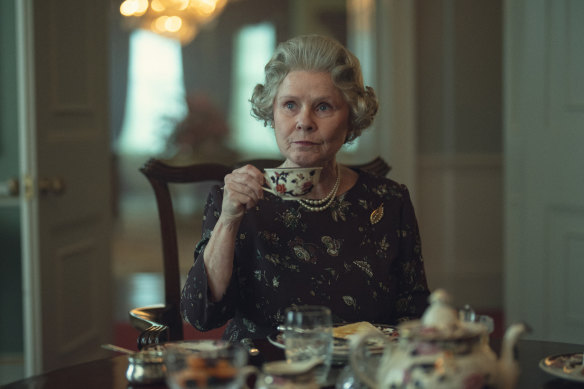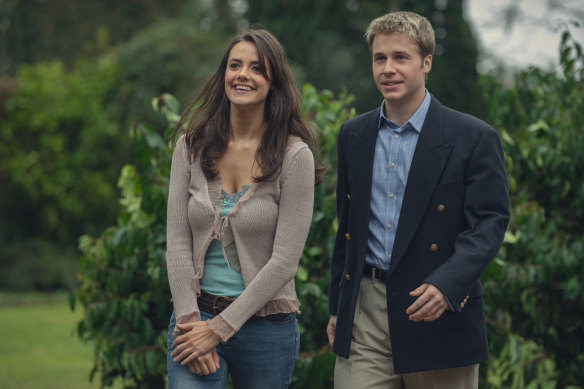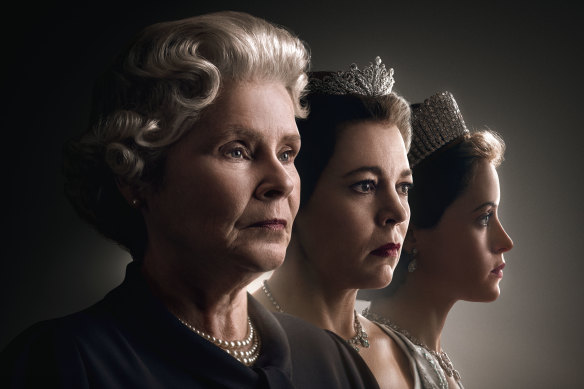The Crown delivers an affecting, evocative final chapter
Save articles for later
Add articles to your saved list and come back to them any time.
The Crown: Season 6, Part 2
Netflix, on demand
★★★★
Anyone who knows how the Royal Family operate on a day-to-day basis these days will tell you that the most sensible advice from within invariably comes from Camilla. To her future husband Prince Charles, in the penultimate episodes of The Crown, she offers this advice: “What kind of a man can look himself in the eye if he is a father and know that he’s failed at that.”
Imelda Staunton in the final season of The Crown.Credit: Netflix
It’s a somewhat innocuous line, intended to remind Charles, adrift after the death of Diana, that he needs to refocus his life on his children. But it is also a line which sends a discomforting ripple through the family’s history of fathers and their offspring: Charles’ relationship with Prince Philip, the absence of Prince Andrew from Prince Philip’s life, and the relationship between Queen Elizabeth and her father, King George VI, which underscored her reign.
The six episodes of the second part of the final season of The Crown are pulling double duty. They must close off the show’s sixth and final season, and they must also close the entirety of the history book on a television series which has become a magnum opus for the small screen, and a flourished autograph from Netflix on the declaration of war it made against traditional TV.
The strength of The Crown remains, in the finality of its sixth season, exactly what made it a distinct and stunning addition to the television slate when it began back in 2016: an inexplicable but compelling intertwining of the filmed story and the real-life characters who populate its dramatic inflection points. When it strays from the crown itself, it weakens. When it understands that the crown is the star of the show, it shimmers.
William (Ed McVey) and Kate (Meg Bellamy) in The Crown’s final season.Credit: Netflix
The series, as a whole, sprang from two earlier projects by screenwriter Peter Morgan: the film The Queen (2006) and his stage play The Audience (2013), both of which starred Helen Mirren. In its infancy – during the reign of its first Queen, actress Claire Foy, for the show’s first two seasons – it spread its wings beautifully, unfurling layers of hitherto unexplored story.
Peripheral players like Princess Margaret (Vanessa Kirby), the Duke of Windsor (Alex Jennings) and Princess Anne (Erin Doherty) were given the centre stage with great dramatic effect. Gillian Anderson’s astonishing Margaret Thatcher, with so much studied detail woven into a near-flawless performance, very nearly stole the show from both Queen and crown.
As The Crown has aged, its focus has narrowed. In its final dramatic convulsions, the supporting cast of Princess Margaret (Lesley Manville) and Princess Anne (Claudia Harrison) claw back some welcome airtime, though they’re always in danger of seeming like the supporting players in a Jane Austen period soap. (Harrison’s Princess Anne, particularly, leans a little too hard on her Miss Bingley-esque sneer. (The real Anne is, by reputation, much funnier.)
On balance too, The Crown has regained its footing after a season opener which leaned both a little too deeply into dramatic invention and away from the existential mystery of the crown itself. With Diana’s story dealt with, the show’s focus shifts to Prince William (Ed McVey) and Prince Harry (Luther Ford). And while it jars to switch the action from Buckingham Palace to the kissing corners of nightclubs, it’s a welcome change from the mawkish and melodramatic handling of Prince William’s grief.
Three queens: Imelda Staunton, Olivia Colman and Claire Foy from The Crown.Credit: Netflix
The royal romance of William and Kate (Meg Bellamy) now steps into the driver’s seat, but never quite matches the power of scenes which knit The Crown to its genesis all those years ago: the backstage fencing between the Queen (Imelda Staunton) and, this season, Tony Blair (Bertie Carvel). Elizabeth’s grapple with the future of the monarchy and her own mortality is also deeply affecting.
There is no doubt that The Crown will always be an impactful and enduring document. Whether it can be considered a properly historical document is less certain, as its early adherence to remarkable detail has been undermined by the later seasons, which tipped the scales of detail smudging and, at times, strayed wholly into fiction.
But somewhere there, in the shadows and behind the glistening of the royal jewels which adorn the show’s opening title sequence, are unforgettable performances from the likes of Foy and Olivia Colman, and the lavish details which complete the illusion, from art director Mark Raggett, set decorators Celia Bobak and Alison Harvey and costume supervisors Kate O’Farrell and Giles Gale, whose work spans all six seasons.
All six seasons of The Crown are streaming on Netflix
Find out the next TV, streaming series and movies to add to your must-sees. Get The Watchlist delivered every Thursday.
Most Viewed in Culture
From our partners
Source: Read Full Article


